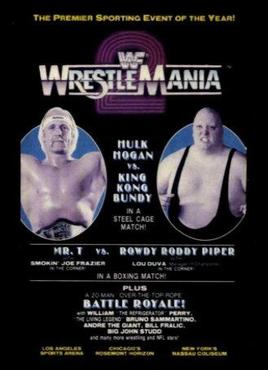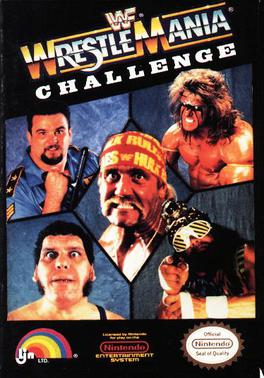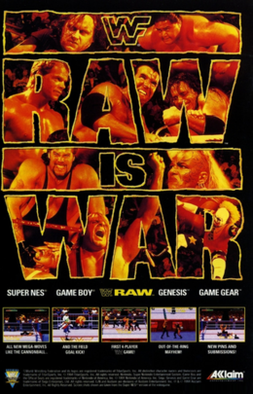
Robert Rudolph Remus, better known by his ring name Sgt. Slaughter, is an American voice actor and retired professional wrestler. He is currently signed to WWE in the ambassador program.

Jacques Rougeau Jr. is a Canadian former professional wrestler best known for his appearances in the 1980s and 1990s with the World Wrestling Federation. He began his career under his real name as half of the tag team The Fabulous Rougeaus with his brother Raymond Rougeau. In 1991, he began a singles career as the Mountie, winning the WWF Intercontinental Heavyweight Championship once. In 1993, he formed three time WWF Tag Team Championship winning tag team The Quebecers with Pierre Ouellet.

Fred Alex Ottman is an American retired professional wrestler. He worked for the World Wrestling Federation from 1989 to 1993 under the ring names Tugboat and Typhoon. As the former, he played a key babyface ally of Hulk Hogan. As the latter, he turned heel to form The Natural Disasters with Earthquake and held the WWF Tag Team Championship.

WrestleMania 2 was the second annual WrestleMania professional wrestling pay-per-view (PPV) event produced by the World Wrestling Federation. The event took place on April 7, 1986, making it the only WrestleMania that was not held on the traditional Sunday until the two-night WrestleMania 36 in April 2020. The event took place at three venues simultaneously: the Nassau Veterans Memorial Coliseum in Uniondale, New York, the Rosemont Horizon in the Chicago suburb of Rosemont, Illinois, and the Los Angeles Memorial Sports Arena in Los Angeles, California.

WWF WrestleMania 2000 is a professional wrestling video game released in 1999 on the Nintendo 64 (N64) console. It was based on the World Wrestling Federation's annual pay-per-view, WrestleMania. Despite the fact that this game is based upon WrestleMania 2000, the game was released five months prior to the actual PPV itself, therefore resulting in the game using the stage design from the 1999 event, WrestleMania XV, instead. Released at the height of the WWF's Attitude Era, WrestleMania 2000 was the first WWF game released by THQ. The wrestling company ended its long relationship with Acclaim Entertainment after witnessing the video game success of its competitor, World Championship Wrestling (WCW), on behalf of THQ. WrestleMania 2000 shares its game engine with the Japan-only release Virtual Pro Wrestling 2: Ōdō Keishō.

WWF WrestleMania X8 is a professional wrestling video game developed by Yuke's and released on the GameCube by THQ in June 2002.

WWE Road to WrestleMania X8 is a professional wrestling video game released on the Game Boy Advance handheld console by THQ in 2002, based on WWE's 2002 pay-per-view WrestleMania X8. The game featured improved gameplay and grappling techniques compared to its predecessors. This game was the Game Boy Advance successor to WWF Road to WrestleMania from 2001 and was succeeded by WWE Survivor Series in 2004. It was one of two games named after the event, the other being WWE WrestleMania X8 for the GameCube, released five months prior in June 2002. Of the three WWE games developed by Natsume Co., Ltd. for the Game Boy Advance, WWE Road to WrestleMania X8 was the most successful in regard to both sales and reviews.

WWF WrestleFest is a professional wrestling video game developed and released by Technōs Japan for arcades in 1991, featuring stars of the World Wrestling Federation (WWF). The game was distributed by Technōs in Japan and North America, and by Tecmo in Japan, Europe and Australasia. It is the sequel to Technōs' previous WWF game, WWF Superstars. Compared to Superstars, WrestleFest adds a variety of different wrestlers to the roster as well as enhanced graphics and sound. There are more voice samples, including commentary and pre-match introductions by WWF ring announcer Mike McGuirk. The voiced cut scenes featuring Gene Okerlund from Superstars returned as well.

WWF WrestleMania is a professional wrestling arcade game released by Midway Manufacturing Co. in 1995. It is based on the World Wrestling Federation (WWF) professional wrestling promotion.

WWF WrestleMania Challenge is a professional wrestling video game based on the World Wrestling Federation (WWF), released in 1990 for the Nintendo Entertainment System by Acclaim Entertainment under the LJN label, and in 1992 for the Family Computer by Hot-B.

WWF WrestleMania is a Nintendo Entertainment System (NES) video game created by Rare and published by Acclaim Entertainment in 1989. It was the first WWF licensed NES game and the second WWF game overall, the first being MicroLeague Wrestling. WrestleMania also marked the beginning of a long relationship between Acclaim and the WWF which lasted ten years. Released just months prior to WrestleMania V, it was intended to help build up to that event. The game's title screen features the tagline for WrestleMania III: "Bigger. Better. Badder".

WWF Super WrestleMania is a multiplatform wrestling video game based on the World Wrestling Federation (WWF), released in 1992 for the Super Nintendo Entertainment System and the Sega Genesis.

WWF Superstars 2 is a video game based on the World Wrestling Federation (WWF), released in 1992 for the Game Boy handheld console by Acclaim Entertainment. It is the sequel to WWF Superstars and the second WWF game for the Game Boy system. The game is similar to WWF WrestleMania: Steel Cage Challenge for the Nintendo Entertainment System, although it runs much faster.

The 1991 Royal Rumble was the fourth annual Royal Rumble professional wrestling pay-per-view (PPV) event produced by the World Wrestling Federation. It took place on January 19, 1991, at the Miami Arena in Miami, Florida. It centered on the Royal Rumble match, a modified battle royal in which participants enter at timed intervals instead of all beginning in the ring at the same time.

WWF Rage in the Cage is a professional wrestling video game released by Acclaim Entertainment on December 21, 1993 for the Sega CD gaming system. It is a spin-off of sorts of LJN's 16-bit WWF games, as the gameplay engine and graphical style are the same as in WWF Royal Rumble for the Super NES and Sega Genesis, also developed by Sculptured Software.

WWF Royal Rumble is a professional wrestling video game released in 1993 for the Super NES and Sega Genesis. Like its predecessor, WWF Super WrestleMania, it is based on the World Wrestling Federation (WWF). It features a variety of match types, including the newly added Royal Rumble match. The game's roster consists of wrestlers who were top stars in the WWF at the time, and each version of the game has five exclusive playable characters.

WWF Raw is a professional wrestling video game based on the television show of the same name produced by the World Wrestling Federation (WWF), released for the SNES, 32X, Mega Drive/Genesis, and Game Boy in late 1994 and early 1995 by Acclaim Entertainment. It is the sequel to the WWF Royal Rumble game that was released in 1993, and is the final part of LJN's 16-bit WWF trilogy. Players can play either One-on-One, Tag Team, Bedlam, Survivor Series, Royal Rumble, or a Raw Endurance Match. Unlike its predecessor, WWF RAW is multitap compatible.

No Holds Barred: The Match/The Movie was a professional wrestling pay-per-view (PPV) event produced by the World Wrestling Federation. The program aired on December 27, 1989, and consisted of the film No Holds Barred in its entirety, followed by a match previously recorded at a Wrestling Challenge taping on December 12 at the Nashville Municipal Auditorium in Nashville, Tennessee. It was one of the few pay-per-view events not made available for streaming at the launch of WWE Network service, although in 2018, the cage match became available as part of the WWE Supertape compilation in the service's Classic Home Video section.

















